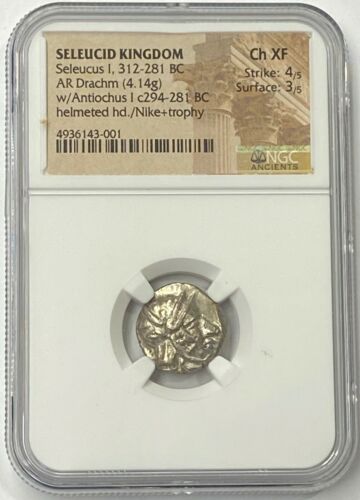-40%
Seleucid Kingdom Seleucid I 312-281BC Silver Drachm NGC CHXF After Alexander III
$ 627.6
- Description
- Size Guide
Description
Seleucid Kingdom Seleucid I 312-281BC Silver Drachm NGC CHXF struck After Alexander the Greats death.The Seleucid’s were the Persian kingdom of the Macedonian dynasty, whose rule began with the collapse of Alexander the Great empire and faded away.
The Seleucid Empire began when Seleucos I Nikator one of Alexander the Great’s favorite General’s and traveling companions. He was given the satrapy (governorship) of Babylon a few years after the death of his friend Alexander in 321 BCE. He would later make moves like Alexander’s other generals to expand the empire for himself. Known as the Diadochi, General Seleucus would murder Perdiccas who for brief period served as Regent of the entire Empire. With the Empire now fractured, Seleucus would war against Ptolemy, Lysimachus, Antigonus, Cassander and Antipater in this power struggle.
SELEUCID KINGS of SYRIA. Seleucus I Nikator. 312-281 BC. Drachm (4.24g) Susa Mint, circa 294-281 BC NGC CHXF 4/5 Strike 3/5 Surface
Obverse- Bust of Alexander the Great as Dionysos to right, wearing helmet covered with a leopard skin and adorned with a bull’s horn and ear. Around Alexander’s throat is another leopard skin, knotted in front by means of the beast's forepaws.
Reverse- The reverse of the coin was political and war mongering in aggressive style. It has a winged, fully draped figure of Nike (Victory) standing on the right. She holds a wreath in her upraised hands, apparently about to place it upon a trophy of arms comprising a helmet, cuirass (a breast- and backplate) with leather straps and skirt, and a star-adorned shield. All the arms are hung upon a large tree trunk, from the lower part of which springs a leafy branch. It has been suggested that this symbolizes the Battle of Ipsus, fought in 301 B.C., in which Seleucus was victorious against his rival General Antigonus. The inscription ΒΑΣΙΛΕΩΣ ΣΕΛΕΥΚΟΥ reads "Seleucus" and "Basileus" (king).
A magnificent example, bright and fully struck with artistry- one of the finest examples of this coinage on the market.
Alexander the Great appears on this coin with some of the attributes of Dionysos, as part of a complex program of imagery that served to identify the conquests of Alexander in India with the god’s own legendary conquests there. The portrait also was meant to remind users of the coin that Seleucus had repeated Alexander’s conquests. The features of Seleucus on this Tetradrachm is thought to resemble those on the rare Philip III gold Staters showing the portrait of Alexander the Great.
Rare in all grades, but this Drachm when found in “Fine Style” gives the artistry needed to see the full beauty of the artist’s depiction of a helmeted Alexander the Great. Over the last 2 years I’ve watched an explosive price increase of this type because of the popularity of this Alexander sleeper issue.
Buy with confidence the coin you see is the coin you’ll receive USPS Priority Insured Shipping with signature confirmation.
This Ancient is guaranteed authentic.
Capstonecoins
Austin Texas 78717













